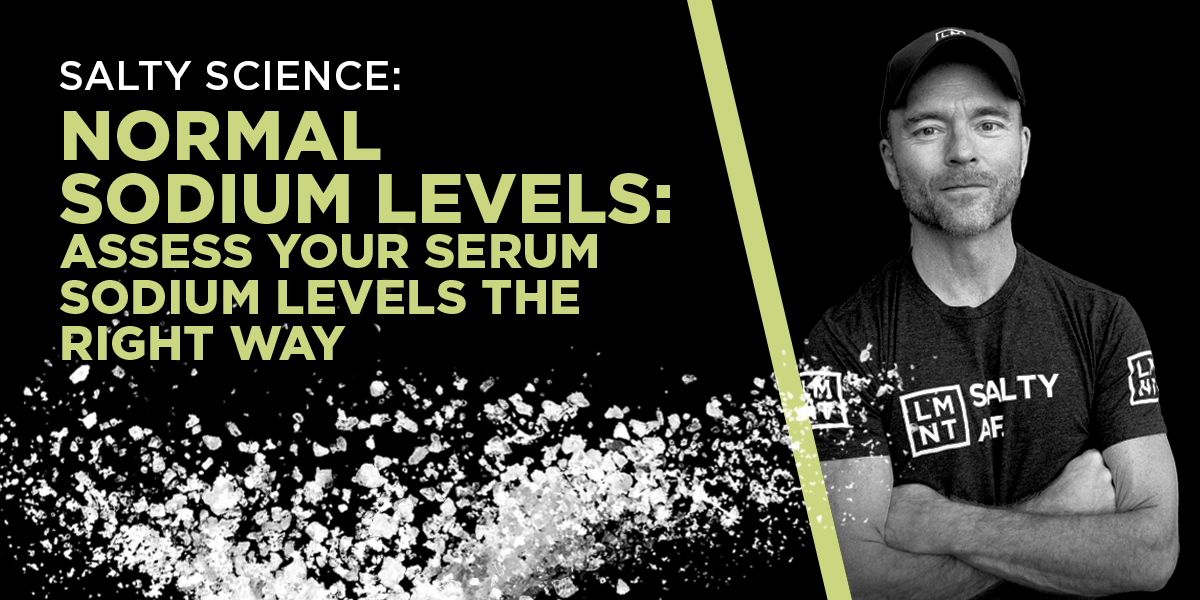Here’s a common scenario. Someone gets their biannual bloodwork, sees normal sodium levels, and concludes that everything is peachy. It’s a serum sodium test. It confirms your sodium status, right?
Not exactly. While a normal result rules out hyponatremia (low serum sodium) and hypernatremia (high serum sodium), it doesn’t rule out sodium deficiency. In fact, it says absolutely nothing about it.
Oddly enough, you can be deficient in sodium and it won’t show up in the lab work. That’s because the electrolyte panel records a snapshot of your blood at a particular moment, not your total intake and excretion of electrolytes day after day.
So, how can you tell if you’re deficient? You’ll feel it in your sleep, mood, energy levels, and physical performance. That is, if you’re paying close attention to your diet and lifestyle. Most people don’t suspect inadequate sodium is making them tired, cramped up, or irritable. They often have an in-range lab result, plus many have been led to believe that less salt is better.
But here’s the thing: salting healthy foods won’t provide the sodium needed to fuel the average person, much less the sweaty athlete or low-carb aficionado. No, a more conscious effort to incorporate sodium into your diet is required.
Again, your body has a tightly regulated system to maintain healthy blood sodium levels. And it’s quite difficult to disrupt, but it can be disrupted. So in this article, I’ll cover how hyponatremia occurs and how to prevent it, but I’ll also explain how sodium deficiency is different, how to assess sodium status, and how to stay salty. Let’s dive in.
What Are Normal Sodium Levels?
Normal sodium levels are generally considered to be between 135 and 145 milliequivalents per liter (mEq/L). This range will vary from lab to lab, but not too widely.
When serum sodium levels fall below 135 mEq/L, it’s called hyponatremia. When they fall below 120 mEq/L, that’s considered severe hyponatremia.
On the other end (above 145 mEq/L) is a high serum sodium condition called hypernatremia. It’s less common than hyponatremia, but it still afflicts populations prone to dehydration.
Both hyponatremia and hypernatremia are serious medical conditions. Both are common in hospitalized patients with kidney issues, heart issues, or a script for diuretics.
People with healthy kidneys typically have normal sodium levels, but this doesn’t mean they’re solid on sodium. I’ll explain why later.
Right now, I want to spend a moment on the extremes: when blood sodium levels rise and fall precipitously.
What Causes Sodium Levels to Fall?
Sodium levels fall when your fluid balance system gets disrupted. Normally this system is on point, but a handful of conditions, medications, and lifestyle practices can throw it off.
For instance, any condition that disrupts heart or kidney function can cause fluids to amass in the body, diluting blood sodium levels. That’s why heart and kidney failure are leading causes of hyponatremia.
A poorly-named condition called syndrome of inappropriate antidiuretic hormone (SIADH) also leads to excess fluid retention. The more ADH you secrete, the more fluids you retain, the more sodium levels fall.
Other conditions that may cause hyponatremia include:
- Addison’s disease
- Cancer
- Liver disease
- Hypothyroidism
- Any illness that causes vomiting or diarrhea
On to medications now. Diuretics, antidepressants, pain pills, and other drugs can alter kidney function (or hormones influencing kidney function) and cause an electrolyte imbalance.
Finally, lifestyle factors. If you want to see otherwise healthy people with hyponatremia, just visit the finish line of a marathon.
Why there? Because many elite endurance athletes over-hydrate with plain water during the race, saturating their blood with sodium-free fluids. Then they stumble across the finish line in a lethargic, low sodium funk.
Symptoms of Hyponatremia
Elite endurance athletes provide a chilling exhibit of the dangers of hyponatremia. Many have perished from this preventable condition.
Most don’t perish, but around 13-15% show the signs and symptoms. These competitors are often treated with IV saline by on-site medical staff.
The symptoms of moderate hyponatremia (120 to 135 mEq/L) include:
- Headaches
- Tiredness
- Low energy
- Muscle cramps
- Mild dizziness
- Brain fog
As sodium levels fall below 120 mEq/L, the symptoms become more serious and include:
- Confusion
- Seizures
- Lethargy
- Light sensitivity
- Cerebral edema
- Brain damage
- Death
Fortunately, preventing and treating exercise-associated hyponatremia (the type of hyponatremia caused by overhydration) isn’t super complicated. Drinking electrolyte water to thirst is a simple and effective prevention strategy. As for treatment, drinking saline (salty water) has been shown to work just as well as IV saline.
When Sodium Levels Get Too High
When sodium levels get too high, it’s called hypernatremia. Hypernatremia is mostly a problem for infants and the elderly, but it can also occur in hospitalized patients.
The main cause of hypernatremia is dehydration (net water loss). To develop hypernatremia, water losses must exceed sodium losses from the blood. This hypertonic dehydration can result from inadequate water intake, excessive sweating, diarrhea, vomiting, or medications.
Hypernatremia presents similarly to dehydration: cramps, thirst, irritability, dry skin, and dark urine. In more severe cases, it can cause lethargy and coma.
High serum sodium is typically remedied by administering extra fluids over 48 to 72 hours. Easing down sodium levels prevents the brain from swelling up like a water balloon.
Elders are more likely to develop hypernatremia due to issues regulating thirst, medication usage, and impaired mobility. But to be clear, seniors can also develop LOW sodium levels due to overhydration.
This is a crucial point. Dehydration and hypernatremia are rare in healthy folks. Widespread calls to drink more water ensure most people get enough fluids.
Sodium Levels vs. Sodium Deficiency
Normal sodium levels do NOT reflect your overall sodium status. They merely suggest that your fluid balance system is working properly.
This system is designed to keep sodium levels within a tight range. Some examples of the system’s brilliance now:
- If you consume a bolus of sodium, blood levels transiently rise—then rapidly normalize as your kidneys excrete the excess.
- Rising sodium levels signal your hypothalamus to make you thirsty. Then you drink something and sodium levels fall.
- If you drink too much sodium-free water, your body stops secreting antidiuretic hormone so you can pee out the excess. (This system fails elite athletes because exercise boosts ADH secretion. They can’t pee out the excess fluid!).
- If you don’t consume enough sodium, you secrete hormones like aldosterone, renin, and angiotensin to increase sodium absorption in the kidneys. (Note: these hormones also increase blood pressure).
- If the sodium deficit becomes chronic, your body pulls sodium from bone to stabilize blood levels. This is why low sodium diets are linked to osteoporosis.
My point is simple. You can have negative impacts from sodium deficiency while showing a “normal” result on a blood test. Given that fact, how do you assess sodium status?
How To Assess and Optimize Sodium Status
Let’s assume for the moment that you have normal serum sodium levels. What next?
Three things:
- Tally your daily sodium intake
- Get to a baseline of 4–6 grams of sodium per day
- Adjust the dosage as needed based on lifestyle factors and any sodium deficiency symptoms
First, use an app like Cronometer to determine how much sodium you consume daily. If you’re eating a whole foods diet, you’ll mostly be logging your salt shaker usage.
I recommend shooting for a baseline of 4–6 grams of sodium per day. That’s the intake linked to the most favorable cardiac outcomes in high-risk patients.
Active and low-carb folks usually need more though. Athletes lose considerable sodium through sweat (3.5 to 7 grams on hot days), and low-carb folks (thanks to low insulin levels) lose considerable sodium through urine.
Calibrating your optimal sodium intake may take some trial and error. It’s important to monitor how you feel, then adjust accordingly.
If you’re experiencing low energy, brain fog, muscle cramps, headaches, or fatigue—you could be sodium deficient. Bump it up by salting food more vigorously and mixing 1-2 tasty sticks of LMNT into your water bottle.
Always thirsty despite drinking plenty of fluids? You might be overdoing the sodium. As you’ll recall, thirst is triggered by rising sodium levels. Try backing off the salt a bit and see if the thirst dissipates.
But most health-conscious folks tend to under-consume salt. My former coaches surveyed thousands of clients—folks eating healthy low-carb diets—and very few were sodium sufficient.
That’s why we made LMNT so salty. Health-conscious people tend to need significantly more dietary sodium to feel and perform their best.
And remember, there’s no lab test for a dietary sodium deficiency. Keep that in mind next time you or a loved one goes in for blood work.

